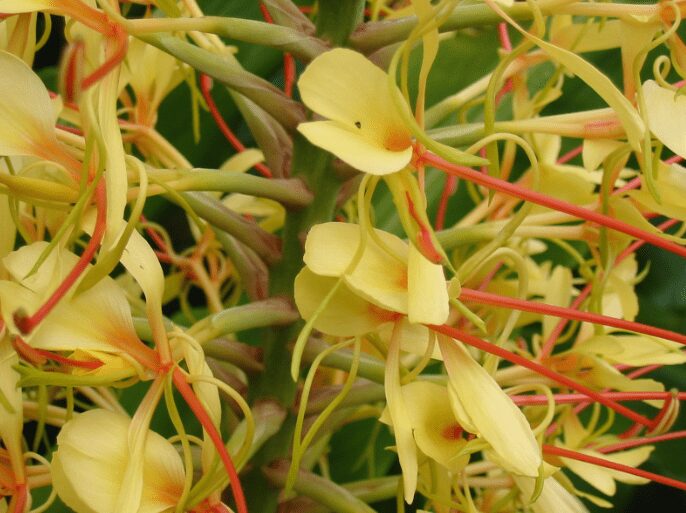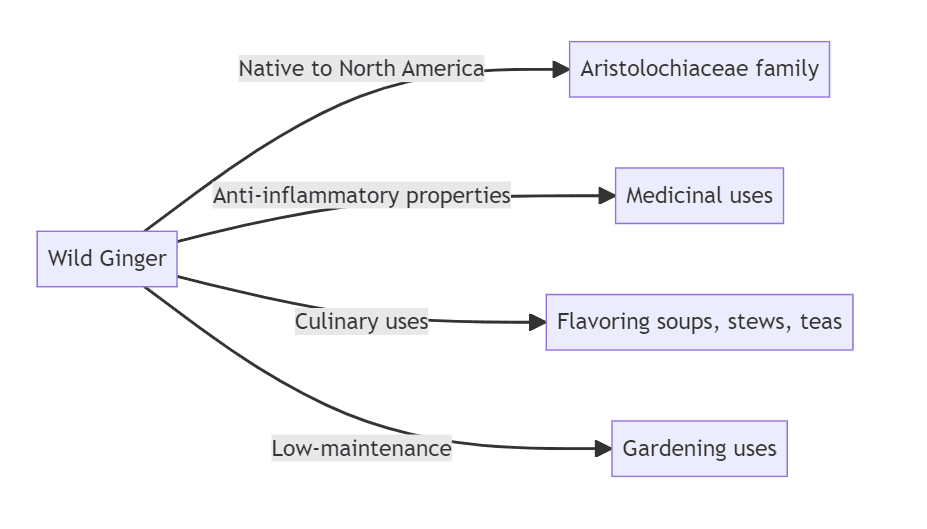
Wild ginger is a popular perennial plant with a wide range of uses. This plant is native to North America and has been used medicinally for centuries.
The scientific name for wild ginger is Asarum canadense, a member of the Aristolochiaceae family.
We will explore the uses and benefits of wild ginger, including its medicinal properties, culinary services, and gardening tips.
Medicinal Properties
Indigenous peoples have used wild ginger for centuries as a medicinal plant. It has anti-inflammatory, antibacterial, and antispasmodic properties. The plant contains essential oils, tannins, and flavonoids that give it medicinal properties.
Wild ginger has been used to treat various conditions, including digestive problems, menstrual cramps, and headaches. Additionally, it is a natural remedy for colds, flu, and respiratory infections.
Health Benefits
It has several health benefits due to its potent medicinal properties. One of the main benefits of this plant is that it relieves inflammation and pain. Wild ginger has been used for centuries to treat various conditions, including arthritis, menstrual cramps, and headaches.
The plant is also a natural remedy for colds, flu, and respiratory infections, making it a great addition to any natural medicine cabinet. The anti-inflammatory properties make it a popular choice for natural pain relief.
Natural Insect Repellent
This plant also has natural insect-repelling properties, making it a great addition to any garden. The plant contains toxic compounds to insects, making it a natural choice for those looking to reduce the use of chemical insecticides in their garden.
Additionally, it has a pleasant aroma that repels mosquitoes and other insects. Planting wild ginger in your garden can help to protect your plants from pests and create a more natural and sustainable garden environment.
Habitat Restoration
Wild ginger is an essential plant for habitat restoration projects. The plant is a natural ground cover and is well-suited for growing in shaded woodland environments. It can help to control soil erosion and provide a natural habitat for wildlife.
It is an important food source for many animals, including deer, birds, and insects. Planting it in your garden can help create a more diverse and sustainable ecosystem that supports the local environment’s health.
Cultural Significance
Wild ginger has played an essential role in many cultures throughout history. It has been used by indigenous peoples for centuries for its medicinal properties and is revered by Native Americans.
Additionally, it has been used in traditional Chinese medicine and is a popular ingredient in many Asian cuisines. The plant has also been used in European herbal medicine for centuries.
Wild ginger continues to be an essential part of many cultural traditions and is a popular choice for those interested in natural medicine and sustainable gardening practices.
Culinary Uses
In addition to its medicinal properties, wild ginger can be used in the kitchen. The plant has a spicy, slightly sweet flavor, making it a great addition to soups, stews, and marinades.
The root can be used fresh or dried and ground into a powder. It can flavor teas and pair well with other spices, such as cinnamon and nutmeg.
Gardening Tips
It makes an excellent addition to any garden. It is a low-maintenance plant that prefers shade and moist, well-drained soil. The plant has heart-shaped leaves, and small, bell-shaped flowers bloom in early spring.
Wild ginger is an excellent ground cover plant and is a natural choice for woodland gardens. It can also be planted under trees or in other shaded areas. The plant is deer-resistant, making it an excellent choice for gardens in areas with high deer populations.

FAQ
Here are some frequently asked questions about Wild Ginger:
What is Wild Ginger?
Wild Ginger (Asarum canadense) is a perennial plant native to eastern North America. It can grow up to 30 cm tall and features heart-shaped, dark green leaves that grow close to the ground. The plant produces distinctive flowers that bloom close to the ground, making them difficult to spot.
What are the uses of Wild Ginger?
It has been used for medicinal purposes for centuries. The plant’s root contains aristolochic acid, used to treat various ailments, including digestive disorders, fever, headaches, and more.
Wild Ginger is also known for its culinary uses. The leaves and rhizomes of the plant can be used to add a unique and spicy flavor to dishes.
It is often used as a substitute for regular ginger in cooking. In addition to its medicinal and culinary uses, Wild Ginger is also a popular ornamental plant.
How to grow Wild Ginger?
WildGinger is a relatively easy plant to grow. It prefers moist, shaded areas with well-drained soil. It can be propagated through seed, rhizome division, or stem cuttings.
When planting WildGinger, it is essential to provide enough space to grow. The plant can spread quickly, so it is best to produce it where it can thrive without overcrowding other plants.
How to harvest and store Wild Ginger?
The best time to harvest Wild Ginger is when the plant is dormant in the fall. The rhizomes can be dug up, and fresh or dried for later use. To store Wild Ginger, dry the rhizomes and store them in an airtight container.
Is Wild Ginger safe to consume?
Wild Ginger is generally safe for consumption in small amounts. However, it is essential to note that the plant contains aristolochic acid, which can be toxic in large quantities. Pregnant women and people with kidney problems should avoid consuming Wild Ginger.
What are the medicinal properties of Wild Ginger?
Wild Ginger has a long history of medicinal use. The plant contains compounds that have anti-inflammatory, antiseptic, and pain-relieving properties.
It has been used to treat various ailments, including digestive disorders, fever, headaches, and more.
Conclusion
Wild Ginger is a plant with seeds that has been used in Asian cuisine for centuries. This spice adds a unique flavor to dishes and is often used in Asian fusion cooking.
If you plan to use wild ginger in your cooking, it’s essential to know that the seeds are the most commonly used part of the plant.
Wild Ginger seeds can be added to soups, stews, and marinades to enhance their flavor. They can also be ground up and used as a meat, fish, or vegetable dish spice.
In addition to its culinary uses, wild ginger also has medicinal properties and has been used for its anti-inflammatory and digestive benefits.
If you want to incorporate wild ginger into your diet, sourcing it from a reputable supplier is essential. You can find wild ginger seeds online or at specialty spice shops. And remember, as with any new ingredient; it’s always a good idea to start with a small amount and adjust to taste.
In conclusion, wild ginger is a versatile and flavorful spice that can elevate your dishes. Whether experimenting with Asian fusion cuisine or adding spice to your favorite recipes, this plant is a great addition to any kitchen.






















